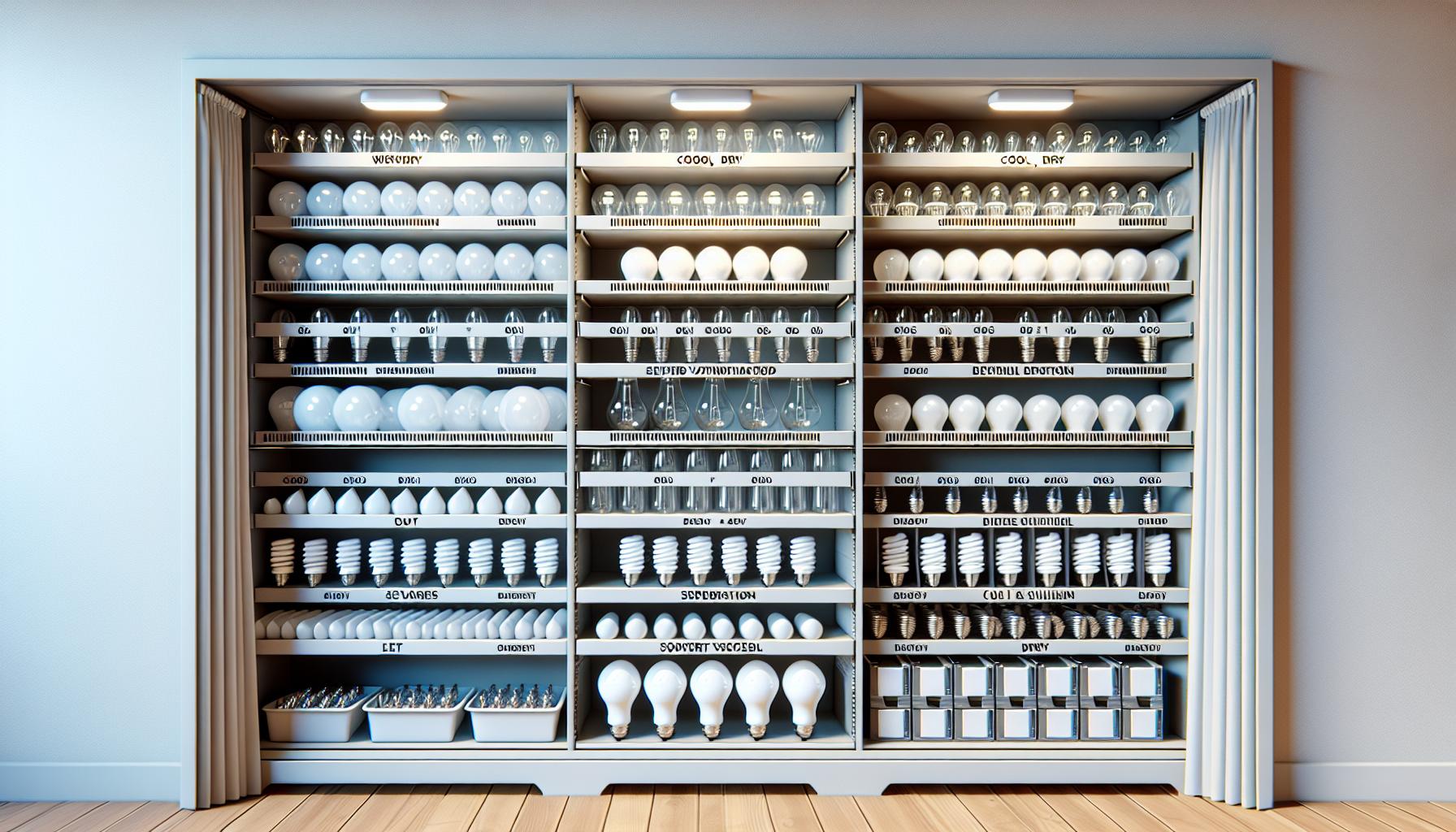Ever wondered if those spare light bulbs you’ve stashed away might go bad like an old battery or a forgotten spice? It’s a common question that pops up when you finally need to replace a burnt-out bulb. You’re not alone in pondering whether those light bulbs have a shelf life.

You might think they’re immune to time, tucked away in their cozy packaging. But before you reach for that old bulb, let’s shed some light on the truth about the lifespan of unused light bulbs. It’s time to uncover if they really expire or if they’ll shine bright when you need them most.
Understanding the Lifespan of Light Bulbs
When you’re knee-deep in home DIY projects, one detail you might gloss over is the little luminary that tops off your space: light bulbs. Sure, they’re just a flick away from brightening your handiwork, but have you ever paused mid-project and wondered, “Do these little guys have an expiration date?”
It turns out, light bulbs do not have a finite shelf life, but their performance can degrade over time. Each bulb is a meticulously designed piece of technology, with different types showcasing varying lifespans. Incandescent bulbs, once the staple in homes, typically promise around 1,000 to 2,000 hours of illumination. On the other hand, modern LED bulbs boast a much longer potential, offering between 15,000 to 25,000 hours.
It’s true, your unused light bulbs sitting in storage aren’t ticking time bombs bound to expiration. Yet, factors such as changes in humidity and temperature can influence their performance. In extreme cases, the soldering on the bulb’s base could corrode, or the filament within could degrade if subjected to consistent moisture or heat variances.
Beyond that, you might find that older stock—even in pristine condition—could be outdated in terms of energy efficiency or light quality. As a lighting enthusiast and home DIY guru, your best bet is to keep an eye on advancements in lighting tech. Lighting, after all, is a dynamic field, with periodic leaps that render existing options obsolete in terms of cost-efficiency and quality.
Given these points, remember to store your surplus bulbs in a cool, dry place away from direct sunlight. It’s like giving your bulbs a cozy little nook that shelters them from the wear and tear of environmental mood swings. This way, when the time comes to screw them in, they’ll shine as though they were purchased yesterday—illuminating your craftsmanship with the brilliance it deserves.
Factors That Affect the Lifespan of Light Bulbs

As a lighting aficionado who loves to delve into DIY projects, you’ll find that the longevity of light bulbs isn’t solely determined by their use. External factors play a crucial role in the lifespan of your bulbs, whether they’re illuminating your home or waiting in storage.
Humidity and Temperature
First off, environmental conditions such as humidity and temperature can dramatically affect bulb performance. You might not think twice about storing your bulbs in the garage or attic, but these spaces often experience extreme temperature fluctuations. High humidity can corrode metal parts, while excessive cold or heat can damage the delicate components inside.
On-Off Cycles
Another point of consideration is the frequency of on-off cycling:
- Bulbs that are switched on and off frequently face more stress, shortening their lifespan.
- Sudden surges of electricity can strain the internal filaments or electronics.
To mitigate this, it’s best to avoid frequently flipping the switch for areas where you don’t need constant light.
Voltage Fluctuations
The quality of your electrical system affects bulb longevity too. Voltage fluctuations are more common than you might suspect, and they can silently and steadily degrade your bulbs. Ensuring that your home’s wiring is up to par can spare you the inconvenience of prematurely dimming bulbs.
Bulb Handling and Installation
And don’t forget about handling and installation. A light bulb’s life can be cut short by:
- Rough handling
- Using the wrong wattage for a fixture
- Screwing bulbs too tightly, causing stress on the connections
Remember, a gentle touch and the right match between bulb and fixture can extend the life of your bulbs significantly.
« Which Light Bulbs Are Yellow: Best Warm Glow Options Revealed
Why Do Light Bulbs Pop? Uncover the Surprising Reasons and Fixes »
By being mindful of these factors, you’re not just lighting up your space—you’re ensuring that the warm glow lasts as long as possible. For those who enjoy the shimmer and shine of well-lit rooms, taking a few preparatory steps means you won’t be left in the dark unexpectedly.
Do Light Bulbs Expire or Go Bad?

Ever stashed away some light bulbs only to find them years later and wonder if they’ve gone past their prime? You’re not alone in this. Light bulbs, like many products, can degrade over time, but “expire” may not be the best term to describe what happens to them. Unlike food, light bulbs don’t spoil in the traditional sense, but they can deteriorate if they haven’t been used for a while.
Shelf life varies among different types of light bulbs. Incandescent bulbs, for instance, have a filament that could degrade even without use. Moisture can creep in and erode the metal, leading to breakage upon first use after a long period. On the flip side, LED bulbs have electronic components that are less prone to such degradation, making them more shelf-stable.
UV exposure and temperature swings in storage can affect the materials in a light bulb. If you’ve kept your bulbs in a garage or attic, where temperatures can skyrocket in summer or plummet in winter, you could be inadvertently reducing their operational life. Although they might not “expire” in the traditional sense, bulbs are certainly susceptible to environmental conditions, even when not in use.
For those who love a good DIY lighting project, it’s crucial to store your light bulbs properly. Keep them in a cool, dry place, away from direct sunlight. This will help protect them from the harsh elements that can shorten their lifespan. Whether you’re using incandescent, halogen, or cutting-edge LED bulbs, storage plays a vital role in their longevity.
Knowing that your stockpile of bulbs might still be good to go can be a relief, especially for budget-savvy or eco-conscious individuals. However, it’s always worth doing a quick check for discoloration, strange smells, or any signs of visible damage that could indicate your light bulbs have indeed gone bad during storage. Taking these precautions ensures that when you screw in that bulb, it illuminates your space without a hitch.
The Importance of Proper Storage

When diving into the world of light bulbs, you’ll find that proper storage is often the key to longevity, especially for bulbs that aren’t used immediately. As an enthusiast for home DIY projects, you’re probably aware that the environment in which you store your bulbs can dramatically affect their performance over time. Just like carefully selecting the perfect lighting for a room, choosing the right storage conditions for your bulbs is crucial.
Temperature and humidity play significant roles in preserving the quality of your light bulbs. It’s essential to store them in a cool, dry place. Extreme temperatures, both hot and cold, can lead to the deterioration of the delicate components inside the bulb. Humidity, on the other hand, can cause corrosion or even mold growth on the electrical contacts, which can be a real hassle when you’re ready to use them.
For the best results, store your bulbs in their original packaging. This isn’t just for organization; these packages are designed to protect the bulbs from environmental hazards. If the original packaging is not available, opt for a container that limits light exposure and is buffered with padding to prevent physical damage. Keep in mind, incandescent bulbs will thank you for a little extra cushioning to protect their fragile filaments.
Consider the following tips for bulb storage:
- Avoid locations with fluctuating temperatures, such as attics or garages.
- Store away from windows where direct sunlight can cause UV damage.
- Use separators or padding to prevent bulbs from knocking together.
- Keep them away from moisture-prone areas to avoid electrical damage.
Don’t forget that the location is just as important as the method. Always select a storage area that’s accessible but won’t subject your bulbs to the daily grind of household activity. After all, even the tiniest nudge can upset the lifespan of your precious lights.
Remember, every time you store your bulbs properly, you’re not just prolonging their life; you’re also ensuring that they’ll be ready to shine brightly when you need them for your next big home makeover project.
How to Extend the Lifespan of Unused Light Bulbs

You already know that proper storage can make all the difference when it comes to unused light bulbs. But, there’s more you can do to keep your bulbs from an early trip to the landfill. Let’s dig into how you can ensure they’re not only around when you need them but also in perfect working order.
Check the Voltage Ratings before using a bulb. Often overlooked, sticking to the correct voltage for your light bulbs can prevent premature burnout. This is crucial when you finally decide to use them. If the voltage in your home is variable, consider using a voltage regulator.
Rotate Your Stock. Think of your light bulbs like perishable goods; rotating your stock means you’ll use the older ones first. This practice keeps all your bulbs in a cycle, reducing the chance any will be left to expire.
- Do Not Remove Protective Coating that comes with some specialty bulbs. This coating is designed to protect against damaging elements. Removing it can shorten the bulb’s lifespan even before you screw it into a socket.
In terms of Quantity Management, it’s tempting to buy in bulk, but purchasing too many can lead to waste. Buy what you’ll use in a foreseeable amount of time. Sales are great but saving a few dollars today isn’t a bargain if you end up with more expired bulbs tomorrow.
Invest in a Good Quality Fixture. A high-quality fixture that prevents electrical surges can extend the life of your light bulbs, whether they’re in use or waiting in the wings. This might seem like an upfront cost, but in the DIY world, quality often equals longevity.
And don’t forget, even with all the care in the world, technology advances and bulbs improve. So, keeping a pulse on the latest lighting trends can also be a good reason to update your stock before your old bulbs have a chance to gather dust.
Conclusion
You’ve got the know-how to keep your light bulbs shining bright for years to come, even if they’re sitting in storage for a while. Remember to match those voltage ratings, rotate your stock, and handle specialty bulbs with care. Be savvy about your purchases—after all, you don’t want more bulbs than you can use. And don’t forget, a quality fixture can make all the difference. Stay in the loop with lighting trends to ensure you’re always a step ahead in making the most of your bulbs. Keep these tips in mind, and you’ll light up your space efficiently and effectively, every time.
Frequently Asked Questions
What should I check before using a light bulb to ensure it lasts longer?
Before using a light bulb, always check the voltage rating to make sure it matches your fixture. This can significantly extend the lifespan of the bulb.
How can I manage my stock of light bulbs effectively?
Rotate your stock of light bulbs by using the oldest ones first. This practice helps in utilizing bulbs before they potentially deteriorate due to long-term storage.
Is it okay to remove the protective coating on specialty bulbs?
No, you should not remove the protective coating on specialty bulbs. This coating is crucial for the bulb’s functionality and longevity.
What purchasing strategy is recommended to avoid wasting light bulbs?
Buy light bulbs in quantities that you can realistically use to prevent waste. Managing your inventory effectively ensures that you do not buy more than you need.
Why is investing in a good quality light fixture important?
Investing in a high-quality light fixture is important because it can provide better electrical support and stability, which can extend the life of your light bulbs.
How can staying updated on lighting trends help extend the life of light bulbs?
Staying updated on the latest lighting trends can inform you about new technologies and practices that may help extend the life of light bulbs, such as advancements in bulb efficiency and durability.




